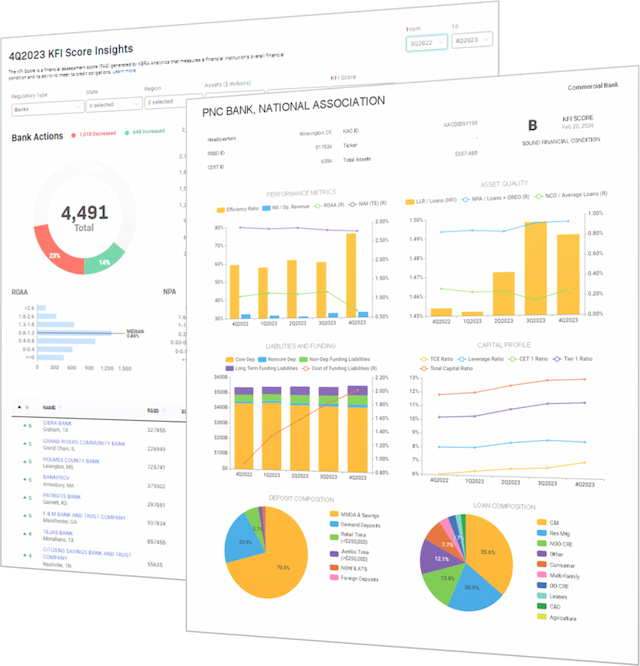KBRA Financial Intelligence
Mortgage Delinquencies Rise as Rates and Tariff Threats Weigh on Housing Market
By KFI Staff
Mortgage Origination Slows, Delinquencies Rise
The average rate on new 30-year mortgages tracked by Freddie Mac is on pace for its first monthly decline since September 2024, having fallen by 10 basis points (bps) in the first three weeks of February but remaining near 7%. Persistently high mortgage rates could continue to discourage prospective buyers who may delay purchases in anticipation of more favorable borrowing conditions. New 4Q 2024 data show that the aggregated mortgage volume held by U.S. banks increased just 1.6% year-over-year (YoY)—equivalent to approximately $45.5 billion—marking the smallest annual increase in three years. Net mortgage growth has now lagged total loan volume growth for a second consecutive quarter.

Among nearly 4,400 U.S. commercial and savings banks reporting residential mortgage holdings for 4Q 2024, the average residential mortgage delinquency rate ticked up to 1.66%, versus 1.42% in the previous quarter. This marks the largest quarterly increase in delinquencies since 2020 and pushes the current delinquency rate above the five-year moving average for the first time in 12 years. While mortgage delinquency rates remain significantly below pre-COVID levels, several factors could contribute to a potential continuation of the upward trend.

Aging Loan Portfolios and Prepayment Risks
The ongoing slowdown in new mortgage originations and acquisitions could contribute to rising delinquency rates. As the average loan age increases, delinquency risk tends to rise, as older loans generally carry a higher likelihood of financial strain. Borrowers who were creditworthy at origination may face economic challenges over time, increasing the potential for missed payments. Additionally, high-quality borrowers often prepay or refinance their loans, leaving a greater concentration of higher-risk loans in portfolios when mortgage inflows slow. This shift could lead to higher delinquency rates, particularly in portfolios with an increasing share of aging loans.
Although the average 30-year mortgage rate has remained above 6% for more than two years, most U.S. homeowners locked in loans at significantly lower rates. According to the Federal Housing Finance Agency’s (FHFA) National Mortgage Database, the average rate on outstanding mortgage loans was just 4.2% in 3Q 2024—the most recently available data. This gap between current market rates and the lower rates held by existing homeowners presents a major hurdle to home sales growth. Many potential sellers are reluctant to give up their favorable rates for higher ones tied to new purchases, further constraining housing market activity.
Potential Impact of Tariffs on Homebuilding and Supply
Home construction activity, a key driver of housing supply, could face additional headwinds due to tariffs. In previous coverage of the potential impacts of tariffs on construction and development (C&D) lending, KFI highlighted concerns about rising costs for building materials, particularly softwood lumber from Canada who is the largest foreign supplier of softwood lumber to the U.S. accounting for 95% of imports over the past several decades. In 2021, the U.S. imposed a 14.5% tariff on Canadian softwood exports. More recently, the Trump administration proposed increasing that duty to 25% beginning in April. In late January, the National Association of Home Builders (NAHB) sent a letter to President Trump, warning that tariffs on building materials from Canada and Mexico risks “slowing down the domestic residential construction industry.” A sharp increase in material costs, exacerbating elevated financing costs, could drive home prices even higher, further dampening residential construction activity and mortgage lending.

NAHB and Wells Fargo’s Housing Market Index slipped to 42 in February — its lowest level since September 2024 and marking the 10th consecutive month below the breakeven level of 50. In a press release that accompanied the data, NAHB noted that “Uncertainty on the tariff front helped push builders’ expectations for future sales volume down to the lowest level since December 2023.”
As a result, new home construction has slowed, with builders likely cautious amid the threat of potential tariff hikes. Housing starts fell sharply at the beginning of the year, with the annual rate of new construction down 9.3% in January—the steepest monthly drop in 10 months. Earlier this month, KFI noted that U.S. commercial banks have reported YoY declines in loans secured by one-to-four-family residential construction projects for six consecutive quarters through 4Q 2024, highlighting continued weakness in the sector.
KFI users can sort by loan categories and the delinquency rate impacting those loans for all banks and credit unions via KFI’s web application, the Data Wizard in KFI’s Excel add-in, as well as the Loan Category and Delinquency Report template from our Template Library. To access our full library of tables and templates, request a demo today.
